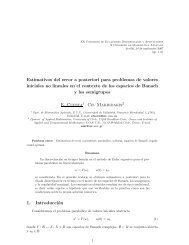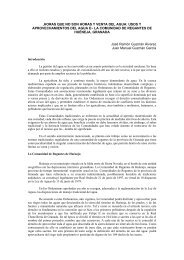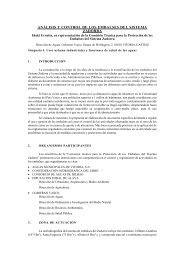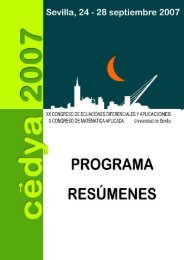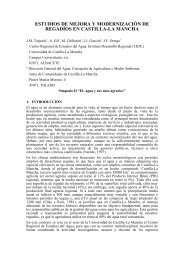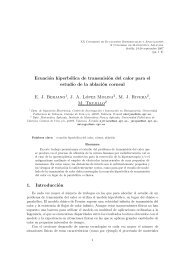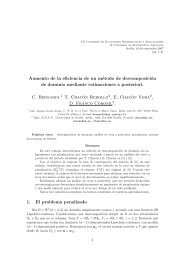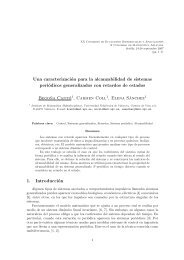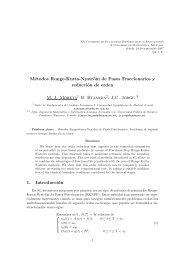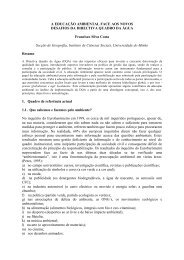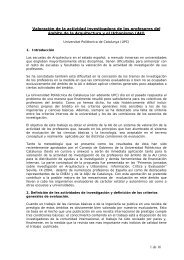LIBRO DE ACTAS (pdf) - Universidad de Sevilla
LIBRO DE ACTAS (pdf) - Universidad de Sevilla
LIBRO DE ACTAS (pdf) - Universidad de Sevilla
You also want an ePaper? Increase the reach of your titles
YUMPU automatically turns print PDFs into web optimized ePapers that Google loves.
Antipattern discovery in Basque folk tunes<br />
among those the most general (not subsumed by any other distinctive pattern). For example, if<br />
the pattern [+2] is not distinctive it would not be reported. If the pattern [-4,+2,+2] is<br />
distinctive, then no more specific pattern (e.g., [4,+2,+2,+1]) would be reported, and in fact the<br />
entire search space un<strong>de</strong>r the pattern [-4,+2,+2] need not be explored.<br />
The MGDP algorithm operates by iteration, setting each class as the corpus , and setting the<br />
rest of the pieces, irrespective of their classes, as the anticorpus (see Figure 1). Patterns are<br />
found within a corpus by tree search over a specified pattern space (e.g., melodic interval<br />
patterns, rhythmic patterns) and data mining parameters including a distinctiveness threshold.<br />
Statistics are computed for each MGDP found and the results sorted by increasing p-value. For<br />
folk songs, the class variable may be used to label any imaginable partitioning of the data, for<br />
example, by the genre of a song, its geographic area of collection (and/or origin, if known), or its<br />
tune family. The algorithm was applied with success to a corpus of Cretan folk music (Conklin<br />
and nagnostopoulou, 2011), which were labeled with 5 toponymic and 11 genre <strong>de</strong>scriptors.<br />
2.3 Antipatterns<br />
An antipattern (anticorpus pattern) is a pattern that is absent or surprisingly rare within a corpus<br />
but occurs frequently in an anticorpus (i.e., is a general rather than a specific pattern) . To<br />
discover such patterns it is tempting to try to enumerate the space of patterns in the corpus from<br />
most specific (longest) to general (rather than general to specific), but this strategy is inefficient<br />
because nearly all conceivable patterns will be infrequent in a corpus. Furthermore, a weakness<br />
of this strategy is that it cannot discover jumping patterns (Dong and Li, 1999): those that are<br />
completely absent in a corpus.<br />
Table 3: Antipatterns in the Cancionero Vasco. Top: for genres; Bottom: for territorios.<br />
An elegant solution is found by noting that there is a natural symmetry to patterns that are<br />
over-represented in an analysis class and those un<strong>de</strong>r-represented in the background. In fact the<br />
MGDP algorithm can naturally be used to discover antipatterns by reversing the roles of corpus<br />
and anticorpus. Furthermore, the p-value of an antipattern has a symmetric meaning: the<br />
probability that it occurs the observed number or fewer times in the corpus. Therefore, by<br />
switching the role of corpus and anticorpus, and modifying the p-value computations to<br />
compute the left rather than right tail of the cumulative hypergeometric distribution, the MGDP<br />
algorithm may be used to discover antipatterns.<br />
3. Results<br />
The 7 territorios and 24 genres in the Cancionero Vasco were used as label dimensions for the<br />
discovery of antipatterns. Therefore, for example, one territorio (e.g., bizkaia) would be taken as<br />
the corpus and the songs in other territories as the anticorpus , and the MGDP algorithm<br />
222



